The formal noise complaints have begun at Lowell Mountain, Vermont, even before the project is fully online. Thirty-two neighbors filed a complaint with the state Public Service Department after two days of troublesome noise this week from ten of the eventual 21 turbines. Low clouds may have contributed to the noise levels, which woke several people in the early morning hours of November 3, and continued through that day and the next.
UPDATE, 12/3/12: Green Mountain Power reports that the excessive noise on the weekend of November 3-4 was caused by a build up of wet snow on the blades. GMP spokesman Robert Dostis says that if neighbors had called them about the noise, the turbines would have been shut down immediately.
About half of the people who signed the letter live within a mile and a quarter of the turbines (6 within a mile, 9 more within a mile and a quarter), with most of the rest between two and three and a half miles away (7 heard it from over 3 miles). Many noted that the noise was clearly audible inside their homes.
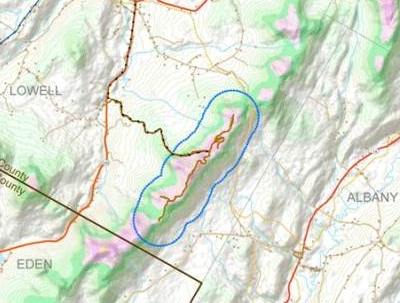 The Lowell Mountain project has been contentious from the start, with mountain preservation activists blocking construction at times. During construction, blast debris from the site crossed property lines of some neighbors, leading to a legal back-and-forth in which land owners were temporarily prevented from being on those parts of their property (where some individuals set up tents in an effort to block the blasting). Kingdom Community Wind, the developer, was pleased that no one lived within a half mile, and few within a mile (see map above; blue ring is half-mile), and confidently quoted a DOE estimate that at just over 1000 feet, the turbines would be no louder than “a quiet bedroom.” And though the project is popular among many in the region, it appears that we are about to be hearing from another community where turbine noise causes more widespread push-back from those living nearby than the reassuring assumptions would suggest.
The Lowell Mountain project has been contentious from the start, with mountain preservation activists blocking construction at times. During construction, blast debris from the site crossed property lines of some neighbors, leading to a legal back-and-forth in which land owners were temporarily prevented from being on those parts of their property (where some individuals set up tents in an effort to block the blasting). Kingdom Community Wind, the developer, was pleased that no one lived within a half mile, and few within a mile (see map above; blue ring is half-mile), and confidently quoted a DOE estimate that at just over 1000 feet, the turbines would be no louder than “a quiet bedroom.” And though the project is popular among many in the region, it appears that we are about to be hearing from another community where turbine noise causes more widespread push-back from those living nearby than the reassuring assumptions would suggest.
UPDATE, 11/15/12: A local radio station adds this response from Green Mountain Power’s Dottie Schnure, who said the noises were an anomaly. “There are some very specific conditions if they happen at once– based on wind speed, weather conditions, moisture in the atmosphere– that can create noise. So, when that happens we are able to modify our operations so we do not create a noise issue.” Schnure says residents are encouraged to call up and report excessive noise, something that wasn’t done immediately in this case.
UPDATE, 11/9/12: See this good piece on a Vermont independent media website; the reporter visited with project owners and opponents the day after the above letter was circulated by the Nelsons.
UPDATE, 11/8/12: A local paper, the (Barton) Chronicle, has published an article detailing some of the comments of those hearing the turbines last weekend; the article is not yet on the paper’s (limited) website, but may appear at this link soon. It’s archived on the National Wind Watch site here. Three people living two to three miles away thought is sounded like a distant jet, while another thought it was wind from an approaching storm. “I had to agree with my wife, finally, that it was not just the wind over the mountains,” said David Lawrence, over three miles away, “If that is their sound it’s totally unacceptable.” Don and Shirley Nelson, among the closest neighbors at just under a mile, have long opposed the project; still, they were shocked at the severity of the noise. “I knew it was going to be bad,” Mr. Nelson said Monday. “1 had no idea it would be this bad.”
“It was just like being tied to a chair with a train going by,” Ms. Nelson said. “And that train took all weekend to go by.” Inside her home, Ms. Nelson added, “it sounded like a terrible chimney fire.”
A man working in his sugar bush between one and two miles from the turbines, called it “the goddamnest roar you ever heard in your life.” He and his son were unable to hear each other, even yelling, when about a hundred feet apart in the woods.
Geoffrey Commons of the state Public Service Department said this week, “We will gladly take complaints, and we are keeping a record. Noise monitoring will be done according to a plan … that will not start until all the turbines are in operation” Mr. Commons said.
When it issued the project a certificate of Service Board set “a strict, objective standard” for maximum turbine noise. It limits sound to 45 decibels outside a neighbor’s home, and 30 decibels inside their bedrooms. “If they’re not meeting that,” Mr. Commons said of GMP, “the board has been very clear that they’ll have to make changes in order to meet it.”

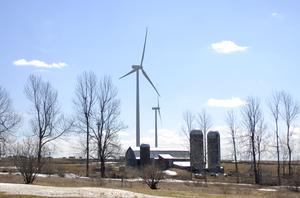 I don’t like to say “I told you so,” but
I don’t like to say “I told you so,” but 
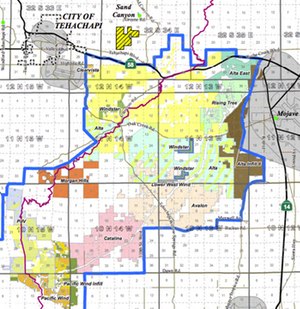 On the map to the left, yellow represents the existing development pictured above, and the other colors each represent a new development. For those living within this roughly 11 x 17 mile Wind Inclusion Area, the prospect is daunting. April Biglay, a local activist who’s been encouraging the county to proceed with caution, attended the first meeting, and said, “I think it’s bittersweet. I think the county is making a huge effort to get under control the production of wind energy. At least the studies are in. At least they are looking at these areas, I mean it’s better than nothing.”
On the map to the left, yellow represents the existing development pictured above, and the other colors each represent a new development. For those living within this roughly 11 x 17 mile Wind Inclusion Area, the prospect is daunting. April Biglay, a local activist who’s been encouraging the county to proceed with caution, attended the first meeting, and said, “I think it’s bittersweet. I think the county is making a huge effort to get under control the production of wind energy. At least the studies are in. At least they are looking at these areas, I mean it’s better than nothing.” 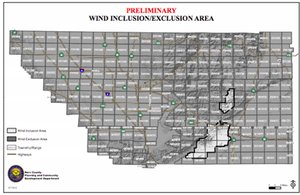
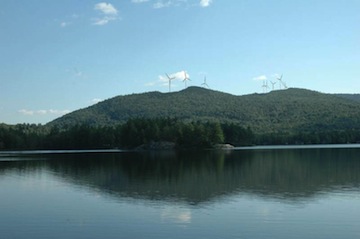 One year-round resident notes that the noise is loudest when his home is downwind of the turbines, and adds, “What is most interesting to me is that they seem loudest on the calmer days. That is, if the wind is barely existent, I can really hear them roaring.”
One year-round resident notes that the noise is loudest when his home is downwind of the turbines, and adds, “What is most interesting to me is that they seem loudest on the calmer days. That is, if the wind is barely existent, I can really hear them roaring.”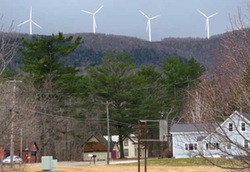 The Record Hill Wind Farm has made the
The Record Hill Wind Farm has made the